|
Strychnine revisited - prompted by the 2021 Nobel Prize awarded for chemistry.
by David Walker, UK
|
Strychnine ... "for its molecular size it is the most complex substance known" - Sir Robert Robinson 1952. British organic chemist, Nobel laureate 1947.
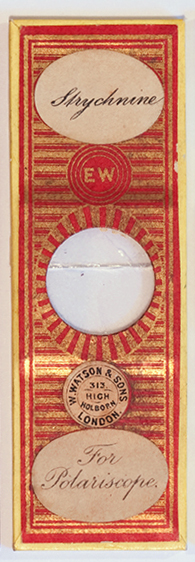 A wide variety of chemical compounds can be responsibly acquired by amateur microscopists and studied after making their own slides. Some of the more toxic compounds are unlikely to be openly available and if they were, it's arguable if hobbyists should be handling them in
a domestic
environment. Safety seemed less of a concern in Victorian times judging by the quite toxic compounds that can be found as prepared slides (or used as a mountant e.g. Realgar, an arsenic compound). One example is strychnine where I have a papered slide sold by W. Watson and Sons although the 'EW' initials on the paper suggest it was made by Edmund Wheeler. Unfortunately it's in a fragile state, the slide has cracked in its history and is held together by the paper and coverslip but with care
can be studied.
A wide variety of chemical compounds can be responsibly acquired by amateur microscopists and studied after making their own slides. Some of the more toxic compounds are unlikely to be openly available and if they were, it's arguable if hobbyists should be handling them in
a domestic
environment. Safety seemed less of a concern in Victorian times judging by the quite toxic compounds that can be found as prepared slides (or used as a mountant e.g. Realgar, an arsenic compound). One example is strychnine where I have a papered slide sold by W. Watson and Sons although the 'EW' initials on the paper suggest it was made by Edmund Wheeler. Unfortunately it's in a fragile state, the slide has cracked in its history and is held together by the paper and coverslip but with care
can be studied.
I've previously shared a study of this slide using various lighting techniques in the 'Victorian Rambles' Micscape 2010 article. My interest was picqued again after reading the background information released to accompany the award of the 2021 Nobel Prize for chemistry to Benjamin
List (Max-Planck-Institut für Kohlenforschung, Mülheim an der Ruhr, Germany) and David W.C. MacMillan (Princeton University, USA) “for the development of asymmetric organocatalysis”.
The Nobel Prize website does an excellent job of providing three levels of information on the yearly awards, the 'Press release', 'Popular information' and 'Scientific background', available as pdfs these were interesting reads on how a new branch of catalysis has already had a profound impact on various tricky syntheses.
An example given was the synthesis of strychnine, this was a 'holy grail' to organic chemists as it is noted to be one of the most complex organic molecules yet quite small. Syntheses become additionally complex when a molecule has tetrahedral carbons with four different attached groups as these are chiral allowing a non-superimposable mirror image of the molecule to exist. Syntheses have to be devised to favour the mirror image required in each step.
Quick facts (source - Wikipedia and Nobel press releases):
- An alkaloid poison which occurs naturally in the seeds of some plants in the Strychnos genus, e.g. the Strychnos nux-vomica tree.
- First discovered by Pierre Joseph Pelletier and Joseph Bienaimé Cavento in 1818 (who also discovered quinine).
- By 1951 final aspects of its structure had been elucidated with the aid of X-ray crystallography.
- The first total synthesis was reported by R B Woodward in 1954. It was a 29 step synthesis with a final yield of just 0.0009% from the original starting materials. Yield is the bane of organic chemists tackling multi-step syntheses. Yield of intermediates for each step can be modest with each additional step required affecting the final yield (further complicated by chiral centres where both mirror structures maybe produced when only seeking one; strychnine has six chiral centres!).
- In 2011 using organocatalysis, the area in which the Nobel Prize was awarded, a much reduced step synthesis was reported by the Vanderwaal group which was 7000% more efficient.
A key aspect of asymmetric organocatalysis is the ability to synthesise the correct mirror image of the compound required. This can be vital especially for drugs. The sad problem with thalidomide was because the chemical occurred in two chiral forms, one was the active drug the other caused birth deformities.
An intriguing aspect of strychnine that can find no mention of to date is why certain plants produce the chemical, does it have a use in the plant? Nature's synthesis is still a complex multistep process aided by yet to be fully elucidated enzymes. The seeds need to be crushed for the toxin to be released so would imagine the seeds would pass through animals that eat the fruit (and beneficial
to disperse the seeds without harming the animal?)
With an interest in molecular models I built it using the Molymod system with the more open bonds. This required some mental gymnastics with a rusty brain to transfer the 2D schematic to its 3D counterpart with the correct conformation of each ring. Even then, double checked with a splendid free iPhone app where can download a molecule from a database and rotate to view from any angle.
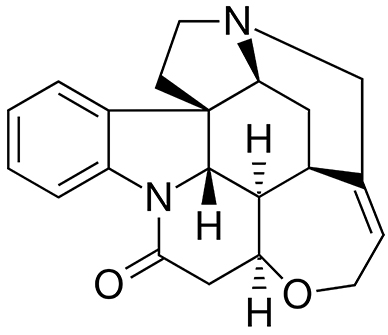
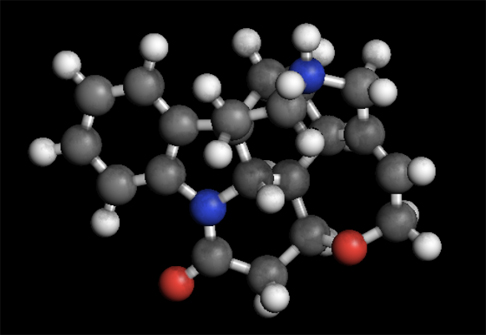
Left, the skeletal formula of strychnine, source Wikipedia, copyright free created by 'Vaccinationist'.
Right, screen capture from iPhone from the 'Best Chemistry app with 3D molecules' created by Sandeep Bhandari.
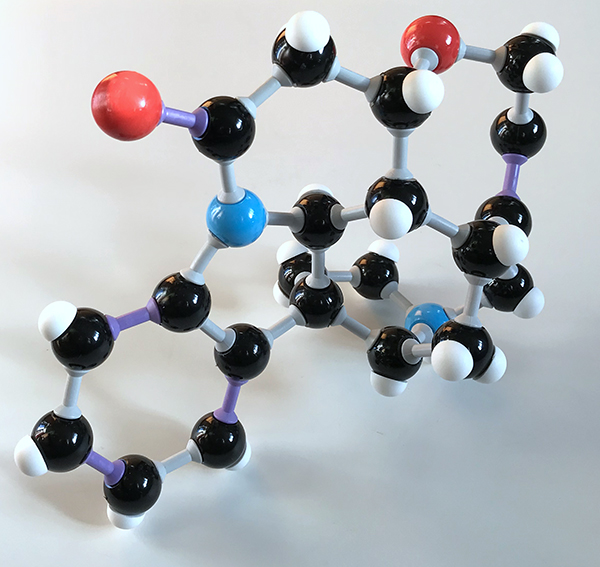
Molymod molecular model of strychnine. Purple are double bonds.
The images below used a Leitz 6.3/0.16
objective on a Zeiss Photomicroscope III with Canon 600D DSLR body using a raised Zeiss 10X Kpl W eyepiece as projection lens.
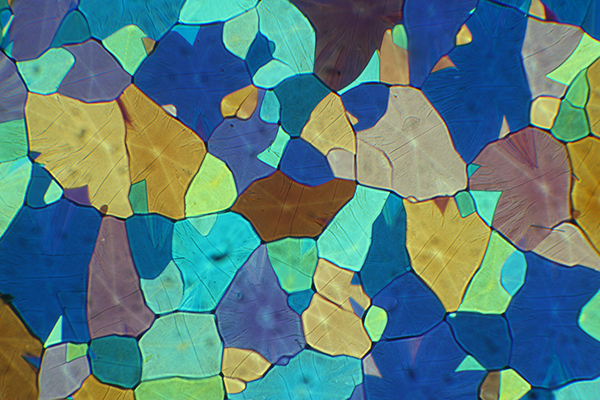
The standard use of crossed polars with lambda tint plates shows the plates well but with little internal detail.
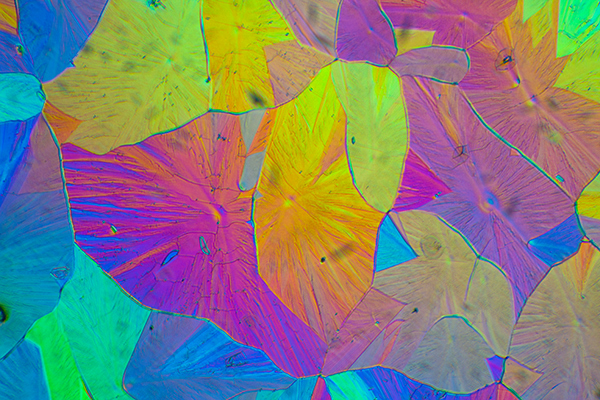
Pseudo-DIC with lambda tint plate (the I prism on the Inko condenser possessed is not recommended at 6.3X but works tolerably well with the 0.32 top lens).
Colours rather flat out of camera so post editing to boost saturation and vibrancy. The best of the techniques tried to reveal internal plate detail.
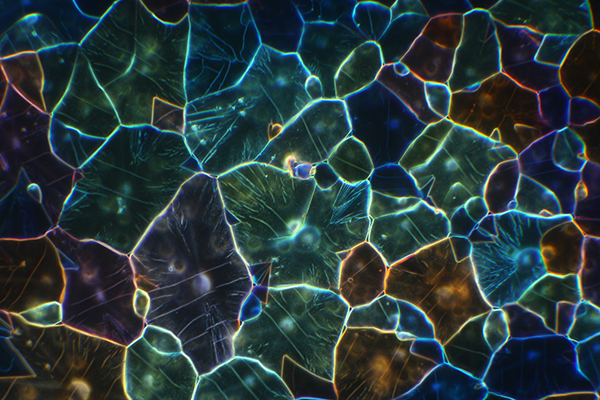
In the previous article the subtle internal detail of the plates was best revealed
in darkfield, with crossed polars and a lambda tint plate. A retry using this technique.
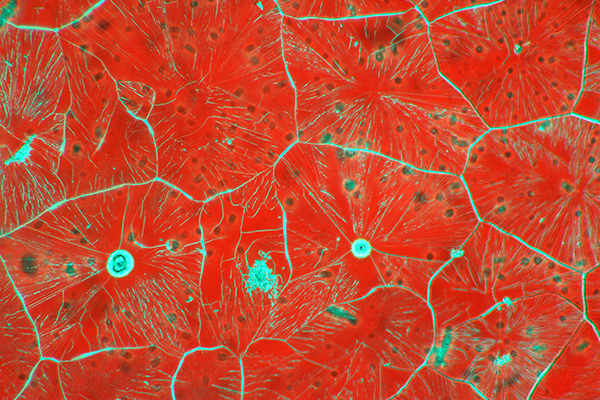
Since the previous article I have explored the used of LED rings to replace the condenser as reported by Dr Kevin Webb (Micscape August 2016). This method was tried as it is an easy route to Rheinberg illumination and also brought out internal detail. A 40 mm LED car headlight 'halo' ring with annular filter replaced the Zeiss condenser
to create green darkfield with a red filter placed
on lamp base for the fill in.
© Microscopy UK or their contributors.
Published in the October 2021 edition of
Micscape.
Please report any Web problems or offer general comments to
the
Micscape
Editor
.
Micscape is the on-line monthly magazine of the Microscopy
UK web site at
Microscopy-UK
© Onview.net Ltd, Microscopy-UK, and all contributors 1995
onwards. All rights reserved.
Main site is
at www.microscopy-uk.org.uk
with full mirror
at www.microscopy-uk.net
.
 A wide variety of chemical compounds can be responsibly acquired by amateur microscopists and studied after making their own slides. Some of the more toxic compounds are unlikely to be openly available and if they were, it's arguable if hobbyists should be handling them in
a domestic
environment. Safety seemed less of a concern in Victorian times judging by the quite toxic compounds that can be found as prepared slides (or used as a mountant e.g. Realgar, an arsenic compound). One example is strychnine where I have a papered slide sold by W. Watson and Sons although the 'EW' initials on the paper suggest it was made by Edmund Wheeler. Unfortunately it's in a fragile state, the slide has cracked in its history and is held together by the paper and coverslip but with care
can be studied.
A wide variety of chemical compounds can be responsibly acquired by amateur microscopists and studied after making their own slides. Some of the more toxic compounds are unlikely to be openly available and if they were, it's arguable if hobbyists should be handling them in
a domestic
environment. Safety seemed less of a concern in Victorian times judging by the quite toxic compounds that can be found as prepared slides (or used as a mountant e.g. Realgar, an arsenic compound). One example is strychnine where I have a papered slide sold by W. Watson and Sons although the 'EW' initials on the paper suggest it was made by Edmund Wheeler. Unfortunately it's in a fragile state, the slide has cracked in its history and is held together by the paper and coverslip but with care
can be studied.





